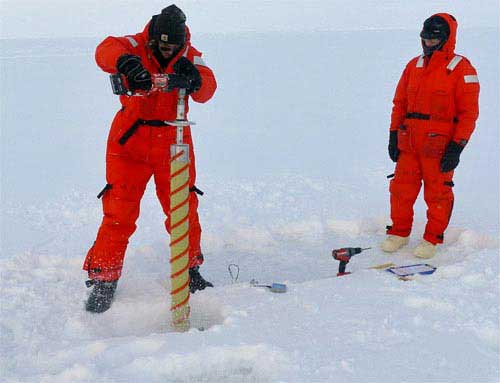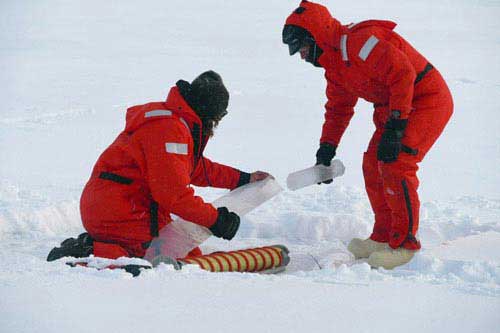Cruise Day 31
Speed 6 knots (kts) Course 157° (SSE) Location Lomonosov Ridge Depth 1392 m
GO DEEPER DISCUSSION: (see previous journal for the questions.)
Alfred Wegner was a German meteorologist and polar explorer who proposed the idea of Continental Drift, which led to the modern theory of Plate Tectonics. He died at age 50 on an expedition in Greenland.
TODAY’S JOURNAL:
I left off in my last post with the North Pole ceremonial activities and ice liberty fun at an end. Ice sampling operations then got underway at about half-past midnight and lasted until nearly 10 am. Like our first ice station, different teams had their own objectives to accomplish in the time we had to work. I opted to tag along with Kyle Dilliplaine, a Master’s Degree Candidate at the University of Alaska, Fairbanks. Carl Lamborg, Assistant Professor at the University of California, Santa Cruz, headed out to assist Kyle with his measurements and sampling.
 Once the North Pole ceremonies and fun wrapped up, scientists headed off the Healy again for a North Pole ice sampling station.
Once the North Pole ceremonies and fun wrapped up, scientists headed off the Healy again for a North Pole ice sampling station.
Kyle is working with Ana Auguilar-Islas and Rob Rember, faculty members at the University of Alaska, Fairbanks, to characterize sea ice whenever we have an ice sampling station (Ana & Rob work on a different aspect of each ice station which I’ll discuss later). His work begins with drilling a hole for Ana and Rob to pump water through for their work, but then he moves on to his own sector of ice to conduct the research he has been tasked with. Kyle begins by measuring the snow depth at several points in his sampling area. The amount of snow on the ice is a major factor in how much light reaches into the ice and sea below, which is important for the photosynthesizing organisms at the base of the food chain. Then Kyle drills his first hole in the ice.
 Kyle Dilliplaine drills an ice core at the North Pole ice sampling station as Carl Lamborg looks on.
Kyle Dilliplaine drills an ice core at the North Pole ice sampling station as Carl Lamborg looks on.
In contrast with the beryllium pumping group (see On Ice, 4 Sept.), Kyle’s drill is smaller but recovers an ice core from the hole (the beryllium pumping drill just leaves ice chips.) The first core is measured and cut into 10cm-long discs that are collected in sample bags. These are melted in Kyle’s shipboard lab to be analyzed for salinity, nutrients available to photosynthetic organisms, and a value called delta O-18. The delta O-18 measures the ratio of O-18, an oxygen isotope with 8 protons and 10 neutrons, to the more common O-16. This ratio gives a clue as to whether the ice originally formed from fresh water, brackish water, or sea water. Interestingly, not all sea ice forms from salt water. Fresh melt water from old ice (which loses salt over time via brine channels) and snow can collect under the ice as a fresh water layer and re-freeze, for example. So just measuring the salinity of sea ice isn’t enough to determine its origin, underscoring the importance of the Delta-O18 measurement.
With a hole now in place through the ice, Kyle deploys an instrument to measure the available light under the ice. This is compared with light reaching the ice surface, which is measured simultaneously with another probe. The under-ice light meter is shaped like a light bulb, to measure light coming from all directions. This is to emulate the way that microscopic cells can absorb light from any direction under the ice for photosynthesis. At the bottom of the pole used to deploy the under-ice light meter Kyle attaches a GoPro camera so he can see what the underside of the ice looks like. In comparison, the light probe on the ice is flat, to emulate the flat surface of the snow that sunlight first encounters as it reaches the frozen Arctic Ocean surface.
 Kyle Dilliplaine measuring incoming light at the surface and under the ice at the North Pole.
Kyle Dilliplaine measuring incoming light at the surface and under the ice at the North Pole.
Kyle then drills another core, this one for temperature profiling. The recovered core is laid out on the ice and small holes are drilled part way into the core every 10cm with a regular cordless drill. A digital thermometer probe is used to get the internal temperature of the core at each interval. This ice is bagged up and returned to the lab’s freezer, and Kyle later saws the discs into flat pieces that he examines with crossed polarizing filters to characterize the ice crystal texture for each segment.
A third core is drilled and again cut into 10 cm sections, these for later chlorophyll analysis. This can’t be done aboard, so Kyle melts these sections, filters them, and stabilizes the samples for return home. The melting ice is buffered with clean sea water to avoid extreme salinity fluctuations that could burst cells of chlorophyll-containing organisms due to osmotic stress. (Perhaps faithful readers have done osmosis labs at school…) When the filtered samples are eventually analyzed, the total amount of chlorophyll-A can be found which serves as a proxy for photosynthetic biomass within the ice at each level sampled.
Kyle next gets a fourth core, this one to study meiofauna (tiny invertebrates living in brine channels within the ice.) He looks for these in his microscope to some extent here at sea but primarily prepares samples to study at length back home. For these the ice is melted, filtered, and the remaining sample preserved. Two of the determinations that can be made from these samples are the density of life within the ice and a breakdown of taxa (kinds of organisms) found.
You might think this would be enough work for one sampling station, but Kyle still has coring to go! His fifth core is bagged up in sterile bags. This ice is melted, filtered, and preserved for later genetic analysis by other researchers. Finally, Kyle drills 13 more cores that go to various GEOTRACES research groups on the ship to compliment the water samples they receive from rosette casts.
 Kyle Dilliplaine and Carl Lamborg collect an ice core sample at the North Pole.
Kyle Dilliplaine and Carl Lamborg collect an ice core sample at the North Pole.
To wrap up his work, Kyle swaps his coring drill for a 2” auger that he deploys to test ice thickness throughout his sampling site. A neat device attached to the bottom of a measuring tape slides down the hole lengthwise but turns sideways like an upside-down “T” to snug up against the underside of the ice. After getting an accurate measurement the device collapses into an “I” shape so it can be retrieved through the ice hole. Kyle also uses this in the core holes, and from these he can determine things like the average and variation of ice thickness at his sampling area.
GO DEEPER!
Why can fresh melt water running through cracks in sea ice pool up under the ice, creating a fresh (or nearly so) layer on top of the water column instead of mixing with seawater from deeper below?
Aloft Con web cam updated every hour Healy Track
That's all for now. Best- Bill

